Also known as the engagement of “Caving Banks” or “Little High Shoals,” the Civil War Battle of Chusto-Talasa took place on Bird Creek near present Sperry in Tulsa County. In November 1861 Col. Douglas H. Cooper, Confederate commander of the Indian Territory, set out with Choctaw-Chickasaw, Creek, and Texas units to subdue Creek Chief Opothleyahola and his Creek and Seminole followers, who refused to accept their nations’ alliance with the Confederate States of America. The Confederates also hoped to confiscate the dissidents’ slaves and enslave all Indian freedmen. Cooper’s first attack on the alerted and fleeing “Union” Indians at the Battle of Round Mountain on November 19 was unsuccessful. The escapees retreated north and took position within the Horseshoe Bend of Bird Creek.
Opothleyahola had perhaps two thousand to twenty-five hundred individuals with him, the majority being women, children, and poorly armed men. The Confederates fielded thirteen hundred soldiers with the addition of two Cherokee regiments. Cooper attacked mid-afternoon on December 9. About dusk a Texas cavalry squadron outflanked the bend, while the First Regiment Choctaw-Chickasaw Mounted Rifles penetrated its center. But Cooper did not have enough ammunition to eradicate the defeated refugees as they fled toward Kansas. Cooper suffered fifty-two casualties plus some desertions from Col. John Drew’s First Cherokee Mounted Rifles. Opothleyahola lost an estimated 150 to three hundred dead and wounded, plus many noncombatants captured.
BIBLIOGRAPHY: Carter Blue Clark, “Opothleyohola and the Creeks During the Civil War,” in Indian Leaders: Oklahoma’s First Statesmen, ed. H. Glenn Jordan and Thomas M. Holm (Oklahoma City: Oklahoma Historical Society, 1979). LeRoy H. Fischer and Kenny A. Franks, “Confederate Victory at Chusto-Talasah,” The Chronicles of Oklahoma 49 (Winter 1971-72). W. Craig Gaines, The Confederate Cherokees: John Drew’s Regiment of Mounted Rifles (Baton Rouge: Louisiana State University Press, 1989).
Commentary by Whit Edwards in “The Prairie was on Fire” pp. 7-9:
Opoethleyohola did not want to join the unionists in Kansas, but he hoped to stay clear of the Confederates. He therefore moved his band north and east and settled into camp north of Tulsey Town on Bird Creek. There they, as well as the Confederates in their camps, suffered an outbreak of the measles, which debilitated both groups Spurred by concerns from the leadership in the Creek and Cherokee tribes that Opoethleyohola would stir up trouble, Cooper took action. On 30 November Cooper was again on Opoethleyohola’s trail The weather had turned fearfully cold and the troops were none too happy to be back in the saddle. On 7 December Cooper pinpointed the enemy camp and received word they might be willing to negotiate. Cooper sent emissaries from Col. John Drew’s Cherokee Regiment into Opoethleyohola’s camp. Later that evening Drew’s regiment suffered 400 desertions from a contingent of 480 men. Some fled back to Fort Gibson, while the majority went over to the enemy and joined Opoethleyohola’s camp. Alarmed that his flank was exposed and the enemy reinforced, Cooper formed a line of battle and waited for an attack. Because his men had slept “on their arms” all night, Cooper feared his force would be too weak to attack, and perhaps too weak to defend, so he proceeded down Bird Creek to Tulsey Town.
As the Confederates crossed the creek, Opoethleyohola ambushed the rear of the retreating column. Colonel Cooper reacted quickly by bringing his troops to bear and sending his wagon train east out of harm’s way. Opoethleyohola used the attack on Cooper’s rear as a ruse to get Cooper to chase the attackers to a battlefield of Opoethleyohola’s own choosing. Old Gouge had his men well posted in a bend of Bird Creek called Chusto-Talasah or Little High Shoals, a natural ambuscade that was easily defended.
The Battle of Chusto-Talasah lasted about four hours as both sides charged and attempted flanking maneuvers. Neither side could get the upper hand. As the day came to an end, the gunfire fizzled, and both sides slipped away under the cover of darkness. Once again Colonel Cooper had not been able to capture or subdue his wily enemy. The fight had exhausted Cooper’s ammunition supply, and he was forced to fall back to Fort Gibson to resupply. Old Gouge’s supplies also were depleted, and he headed northwest toward Shoal Creek to a place called Chustenahlah.
National Park Service/American Battlefield Protection Program Summary
Chusto-Talasah
Other Names: Caving Banks
Location: Tulsa County
Campaign: Operations in the Indian Territory (1861)
Date(s): December 9, 1861
Principal Commanders: Chief Opothleyahola [I]; Col. Douglas H. Cooper [CS]
Forces Engaged: Creek and Seminole [I]; Indian Department [CS]
Estimated Casualties: Unknown
Description: Following Chief Opothleyahola and his Union force’s defeat at Round Mountain, he retreated northeastward, in search of safety. On December 9, 1861, the force was at Chusto-Talasah, or Caving Banks, on the Horseshoe Bend of Bird Creek when Col. Douglas H. Cooper’s 1,300 Confederates attacked Chief Opothleyahola around 2:00 pm. Chief Opothleyahola knew Cooper was coming and had placed his troops in a strong position at Horseshoe Bend. For almost four hours, Cooper attacked and attempted to outflank the Federals, finally driving them east across Bird Creek just before dark. Cooper camped there overnight but did not pursue the Federals because he was short of ammunition. The Confederates claimed victory. Chief Opothleyahola and his band moved off in search of security elsewhere. Although the Confederates had gained a victory, they would win a resounding one later in the month at Chustenahlah.
Result(s): Confederate victory
CWSAC Reference #: OK002
Preservation Priority: IV.2 (Class D)
See also: The Battle of Round Mountain - November 19, 1861; The Battle of Chustenahlah - December 26, 1861.
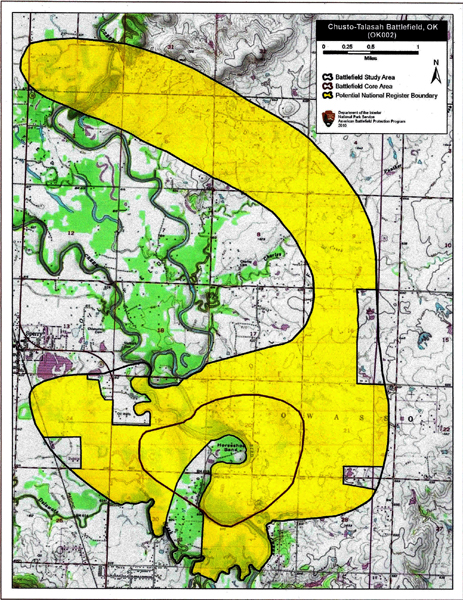
Map of the Chusto-Talasah Battlefield from the May 2010 Civil War Sites Advisory Committee’s Oklahoma Update
Official Records of the War of the Rebellion
Chusto-Talasah – December 9, 1861
Series I, Volume 8
Excerpt from Colonel Douglas H. Cooper’s report from Fort Gibson, January 20, 1862
On the 8th of December, about 12 o’clock, I found him encamped on Bird’s Creek. After a brief interview, in which he informed me that Hopoeithleyohola had sent a message expressing a desire to make peace, I authorized him to send in return to Hopoeithleyohola the assurance that we did not desire the shedding of blood among the Indians, and proposed a conference next day. Major Pegg, of the Cherokee regiment, was sent, and I proceeded to encamp about 2 miles below Colonel Drew, on the same creek. Much to my surprise, about 7 o’clock at night several members of Colonel Drew’s regiment came to my camp with the information that Major Pegg had returned without being able to reach Hopoeithleyohola, who was surrounded by his warriors, several thousand in number, all painted for the fight, and that an attack would be made upon me that night; that the Cherokee regiment, panic-stricken, had dispersed, leaving their tents standing, and in many instances even their horses and guns. Soon afterwards the wagon-master of the Cherokee regiment and his teamsters, true to their duty, brought down a portion of their trains and provisions. Lieutenant-Colonel Quayle, with a squadron of the Fourth [Ninth] Texas Cavalry, was then sent to Colonel Drew’s relief and to report the condition of his camp. Colonel Drew and 28 members of his regiment soon afterwards came into my camp and fully confirmed the statements made by the first party and declared their intention to assist in its defense.
My whole command had been, on the first alarm, formed and so disposed as to protect and defend our camp on all sides and remained under arms all night, quietly awaiting the enemy.
No attack was made, however, and soon after daylight Actg. Asst. Adjt. Gen. R.W. Lee, with a small party, went up to Colonel Drew’s deserted camp and found all standing and apparently untouched. Colonel Drew, with the Cherokees, a portion of the Texas cavalry, and some Choctaws, went up and brought away the camp equipage, and other property found there. About 11 o’clock I recrossed the creek and proceeded down on the east side, with a view of taking a position which would enable me to keep open communication with the depot at Coweta mission and with re-enforcements of Creeks, Seminoles, and Choctaws who were expected at Tulsey Town.
Captain Foster, of the Creek regiment, was sent with two companies of that regiment again across towards Parks’ Store, on Shoal Creek, to ascertain whether the enemy had come down from the mounts, and also to look after Captain Parks and his men, who had gone on a scout the night before to the rear of Hopoeithleyohola’s camp.
After proceeding down Bird Creek about 5 miles, two runners from Captain Foster reached me at the head of the column, stating he had found the enemy in large force below. Parks had exchanged a few shots with them, taken 6 prisoners¸ and was retreating, hotly pursued. Scarcely had this intelligence reached me before shots were heard in the rear. Hastily directing the Cherokee train to be parked on the prairie and a sufficient guard placed over it, the forces were formed in three columns, the Choctaws and Chickasaws on the right, the Texans and Cherokees in the center¸ and the Creeks on the left, and the whole advanced at quick gallop upon the enemy, who had by this time shown himself in large force above us, along the timber skirting the main creek for over 2 miles, as well as a ravine extending far out into the prairie. A party of about 200 having attacked our rear guard, Captain Young, in command of a squadron of the Choctaw and Chickasaw regiment, being in rear of the main column, perceiving the encounter, wheeled his squadron and advanced rapidly towards the enemy. Upon his approach the party retreated towards the timber on Bird Creek.
The leading companies of the Choctaw and Chickasaw regiment, commanded by Captains Jones and McCurtain, were directed to the right, so as to form a junction with the squadron under Captain Young. Col. D.N. McIntosh, with his Creek regiment, was ordered to turn the right of the enemy on the creek. That portion of the enemy on the ravine in the prairie were driven by the Choctaws and Texans across the open ground intervening between it and timber on the creek. The position then taken up by the enemy at Chusto-Talasah, or the Caving Banks (the Creeks call the place Fonta-hulwache, Little High Shoals), presented almost insurmountable obstacles to our troops.
The creek made up to the prairie on the side of our approach in an abrupt, precipitous bank, some 30 feet in height, at places cut into steps, reaching near the top and forming a complete parapet, while the creek, being deep, was fordable but at certain points known only to the enemy. The opposite side, which was occupied by the hostile forces, was densely covered with heavy timber, matted undergrowth, and thickets, and fortified additionally by prostrate logs. Near the center of the enemy’s line was a dwelling house, a small corn-crib, and rail fence, situated in a recess of the prairie at the gorge of a bend of the creek, of horseshoe form, about 400 or 500 yards in length. This bend was thickly wooded, and covered in front, near the house, with large interwoven weeds and grass, extending to a bench, behind which the enemy could lie and pour upon the advancing line his deadly fire in comparative safety, while the creek banks on either side covered the house by flank and reverse.
The Creeks, commanded by Col. D.N. McIntosh, on the left came soon into action, and, charging the enemy with great impetuosity, met them in hand-to-hand encounter, drove them from the timber, and dispersed them in every direction. On the right the Choctaws and Chickasaws boldly charged on horse to the bank of a ravine near the creek under a heavy fire, and, dismounting, drove back the enemy, who disputed every step of their advance with the greatest obstinacy and bravery. Major Laflore, Captains Jones, McCurtain, and Reynolds were particularly conspicuous in this part of the engagement; also Colonel Drew and his men, who acted with the Choctaws and Texans. Almost simultaneously with these movements on the right and left a detachment of the Texas cavalry, under Lieutenant-Colonel Quayle, made a charge to the left of the Choctaw and Chickasaw regiment and routed the enemy in that quarter; then, changing position to the right of the line, warmly engaged the Indians concealed about the creek and ravines. Another detachment of the Texas cavalry, under Colonel Sims, after making a demonstration to the right of the Creek regiment, moved up the creek about 1 mile, joined Lieutenant-Colonel Quayle, and assisted him in completing the rout of the enemy in that direction. In the mean time the enemy appeared in large force about the house at the bend, and Captain Young, of the Choctaw and Chickasaw regiment, was ordered with his squadron, about 100 strong, to attack them. The charge of the squadron was made in gallant style to the timber below the house, and, there dismounting, moved up under cover of the fence.
The enemy were driven from their stronghold and pursued far into the bend, where, receiving on the flank and unexpected fire, the squadron took position at the house. Being then re-enforced by some men from Captains Reynolds’, McCurtain’s, and Hall’s companies, of the Choctaw and Chickasaw regiment, the conflict with the persistent foe was renewed with increased vigor, and after a fierce struggle the enemy was forced, with heavy loss, through the bend and across the creek.
Our troops, changing position at this juncture to meet a flank fire again on the right, the enemy in front rallied, and by their direct firing from the creek and on the right and rear compelled a retreat again to the house. At this time the force of the enemy at this point was not less than 500, and at no time during the conflict here did our force equal one-half that number. The combat now was at close quarters, and raged with great fury on both sides for some half hour, the enemy alternately yielding and advancing and pouring upon our troops a galling fire. While thus engaged the horses of our men were menaced in rear, and, the alarm being given, caused a movement in that direction. The horses being secured, the troops formed again in line at some distance in front of the house.
I would particularly notice here the conspicuous conduct of Asst-Adjt. Gen. R.W. Lee, who fought on foot with the men, cheering and encouraging them during the conflict at this point, and who here received a contusion, his life probably being saved by his pistol-belt turning the ball.
A few minutes afterwards a detachment of Creeks, under Col. D.N. McIntosh, opportunely came up to the relief of the exhausted men of the Choctaw and Chickasaw regiment, and, throwing themselves upon the enemy, closed the battle.
The firing now entirely silenced, the enemy disappeared from our entire front, and the sun having set, the troops were withdrawn and marched to camp. The battle lasted over four hours.
On the next morning the Choctaw and Chickasaw regiment, the Creek regiment, Colonel Drew and his Cherokees, and a portion of the Texas regiment returned to the battle ground. The enemy had retreated to the mountains.
After burying our dead we followed the train, which had been sent with the wounded, under Colonel Sims, to Van’s, and encamped again for the night within a few miles from the battle-field.
The force of the enemy in the engagement at Chusto-Talasah was certainly over 2,500. Several Cherokee prisoners stated it at 4,000. This was also major Pegg’s estimate after his visits to Hopoeithleyohola’s camp. Their loss, as admitted by prisoners taken in our last scout, was 412. It probably was 500 in killed and wounded.
The force on our side actually engaged did not exceed 1,100, a strong guard being necessary at the Cherokee train. Our loss was 15 killed and 37 wounded.
The officers and men under my command behaved throughout the engagement at Chusto-Talasah on the 9th of December in such manner as to meet unqualified approbation, and coming under my personal observation I would mention as worthy of especial notice and commendation the conduct of the following:
Col. D.N. McIntosh, Creek regiment; Lieut. Col. William Quayle, Texas regiment; Actg. Asst. Adjt. Gen. R.W. Lee; Maj. Mitchell Laflore, Choctaw and Chickasaw regiment Mounted Rifles; Actg. Adjt. Joseph A. Carroll, Choctaw and Chickasaw regiment Mounted Rifles; Capts. R.A. young, Choctaw and Chickasaw regiment Mounted Rifles; Lem. M. Reynolds, Choctaw and Chickasaw regiment Mounted Rifles; Joseph R. Hall, Choctaw and Chickasaw regiment Mounted Rifles; Willis Jones, Choctaw and Chickasaw regiment Mounted Rifles; Jackson McCurtain, Choctaw and Chickasaw regiment Mounted Rifles; W.B. Pitchlynn, Choctaw and Chickasaw regiment Mounted Rifles; Lieuts. J.W. Wells, Choctaw and Chickasaw regiment Mounted Rifles; James F. Baker, Choctaw and Chickasaw regiment Mounted Rifles.
First Serg. Samuel P.C. Patten particularly distinguished; Capt. Alfred Wade, Choctaw battalion, and my young bugler, Nathaniel J. O. Quine.
The actual loss of the enemy in this engagement far exceeded our first estimate, and, although calculated to dishearten them, was of less importance than the moral effect produced. They had learned that their superior numbers could not compensate for the determined valor of our troops and that they could not successfully meet them in combat; that whenever we could find them we could defeat them, and that without material aid from abroad Hopoeithleyohola’s party must be entirely destroyed. Impressed with this conviction, the main body of Hopoeithleyohola’s army retired hastily towards Kansas, where an asylum had been offered them. This statement is made by intelligent prisoners, confirmed by the appearance of the trails leading towards Kansas seen on our scout two weeks afterwards.
Report of Col. D.N. McIntosh, First Creek Regiment, of engagement at Chusto-Talasah
CAMP PLEASANT,
Cherokee Nation, December 16, 1861
SIR: According to your request I will hereby give you a brief account of the battle at High Shoal, Cherokee Nation, on the 9th instant:
The engagement took place about 2 p.m., and continued for [the] space of three and a half or four hours. Without any doubt our enemies had the following advantages over us:
1st. From all appearances it was a premeditated affair by them. They had placed their forces in a large creek, knowing by marching across the prairie that we would be likely to pass in reach of the place.
2d. The ground they had selected were extremely difficult to pass, and in fact most of the banks on the creek were bluff and deep waters, so that no forces could pass across only at some particular points, which were only known to them.
3d. This place was fortified also with large timber on the side they occupied, and on our side [the] prairie extended to the creek, where the enemies were bedded, lying in wait for our approach.
Having completed the above plan, they sent out to us a small portion of their forces to make the attack, in order to draw us down to their desired and selected place, which was done on our rear guard, and immediately we marched on to our enemies, taking the left division, while your command on the right and Texas regiment occupied he middle division. Thus the engagement was generally commenced. Our men, without any exception, fought bravely, and finally the Creek regiment, under my command, charged upon the enemy and chased them out from their strong fortified place and took the creek from them, after which I ordered my regiment to march out upon the prairie, and about that time a rumor came to me that you were still engaged in fighting on [the] right, and I ordered my regiment to your relief.
Our loss in the battle was 2, and from best information I have heard [the] Choctaw regiment lost 3 on the battle-field and 2 died since from wounds; and [the] Texas regiment 2 and 1 from [the] Cherokee regiment, making our total loss [in killed] 10 and about 21 wounded.
The enemy’s loss, from the best information I can gather, was 27 killed and seen on the battle-field, and from the signs a greaqt many dead were concealed or carried off during the night, and [the] wounded could not have been less than 200 or 300.
[D.N. McINTOSH, Colonel, &c.]
Col. D. H. COOPER, Commanding Indian Brigade
Report of Col. John Drew, First Cherokee Mounted Rifles, of engagement at Chusto-Talasah
FORT GIBSON,
Cherokee Nation; December 18, 1861
SIR: I have the honor to report to you that the First Regiment Cherokee Mounted Riflemen, under my command, reached Bird Creek in the forenoon of Saturday, the 7th instant. It consisted the evening of that day of about 480 men, rank and file. The hostile Creeks were encamped from 6 to 8 miles distant.
The day following, under your instructions and with the concurrence of Colonel McIntosh, commanding the Creek regiment, I authorized Major Pegg to assure Hopoeithleyohola and party of your desire for a peaceable settlement of the difficulty with the Creeks, and that you had no wish to prosecute a war against them. Major Pegg was accompanied to the Creek camps by Capts. George W. Scraper and J.P. Davis and Rev. Lewis Downing. Before they returned and late that evening I found that there were only about 60 men in camp, and that a report was circulating that we were to be attacked by an overwhelming force then at hand. I ordered my horse to be saddled, and while in the act of [throwing] a blanket on my saddle Captain Benge came up and said we had better be off, as the enemy were upon us. After proceeding a part of the way to your camp the party returned to secure the ammunition. Major Pegg was then in camp, and reported that he had seen a large number of warriors painted for battle, who would be down upon us that night, and that he had been allowed to return only on the plea of removing some women and children from danger. This renewed the excitement, and as it [was] now quite dark, the party dispersed in squads. Information had been conveyed to you of the dispersion of the regiment, and while myself, Captain Fields, and a few others were making our way to your camp the squadron of Texas cavalry, which had been instructed to secure the public property in our camp, was fallen in with. This prompt movement saved my train, tents, & c.
Major Pegg, Adjt. James S. Vann, Capts. Davis and J.D. Hicks, Lieuts. S.H. Smith, Jesse Henry, Anderson Benge, Trotting Wolf, and several privates pursued their way to Fort Gibson.
Captains Vann, Pike, and Scraper, and Lieutenants White-Catcher, Eli Smith, Foster, Bearmeat, and N. Fish, with parts of their companies, were missing, and doubtless were in the camp of Hopoeithleyohola or made their way there.
Capt. James McDaniel and Lieuts. Wat Stop, N.D. Bear, and Skieyaltooka were absent, but were almost certainly at the same place.
The unarmed portion of the regiment – which consisted in the aggregate of about 1,200 in number – were left at his place in camp, with the following officers: Lieut. Col. William P. Ross, commanding; Capt. N.B. Saunders and Lieutenants Sanders, Hawkins, Ahmer-cher-ner, Crab-grass Smith, Fogg, Little Bird, Young, Webber, Downing, Drew, Ulteesky, and Deer-in-Water, and a surgeon – Corden.
The following-named officers and privates were with me in your camp and present at the battle of Bird Creek on the 9th instant: Company F: Capt. Richard Fields, whose horse was shot; Lieut. Broom Baldridge, killed; Sergt. Dempsey Handle, and Privates Creek McCoy, Situwakee, and Tracker. Company D: Capt. J.N. Hildebrand and Lieuts. George Springston and Ezekiel Russell, Private Nelson Hogshooter. Company H: Capt. E.R. Hicks, Lieut. George W. Ross, Sergts. William Hewbanks, Alan Ross, and Peter; Privates Henry Meigs, Richard Robinson, Carter Oo-yor-lor-cha-he, and Coming Deer. Company K: Capt. Pickens M. Benge, Lieut. George Benge, Privates Oliver Ross, Thomas Ross, Broad Christy, Thomas Yah-hoo-lar, and Adam (a Creek); Surg. James P. Evans, and Expressman William S. Coodey.
The deportment of these few officers and men, under the peculiar circumstances of their situation, was highly honorable to them. The teamsters present also deported themselves in a creditable manner throughout.
The causes which led to the dispersion of the regiment arose from a misconception of the character of the conflict between the Creeks, from an indisposition on their part to engage in strife with their immediate neighbors, and from the panic gotten up by the threatened attack upon us. The regiment will be promptly filled and ready for service.
For the very kind manner in which you were pleased to speak of myself and those who adhered to their obligations in your note calling for this report I beg you to accept my grateful acknowledgments.
I have the honor to be, sir, very respectfully, your obedient servant,
JOHN DREW, Col., Comdg. First Regiment Cherokee Mounted Riflemen.
Col. D.H. COOPER, Commanding Indian Department
Report of Col. William B. Sims, Ninth Texas Cavalry, of engagement at Chusto-Talasah
REGIMENTAL HEADQUARTERS,
Fort Gibson, Ind. T., December 15, 1861.
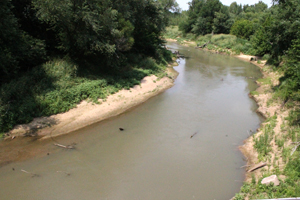
Bird Creek at Horseshoe Bend in July 2011. The Battle of Chusto-Talasah was fought in this vicinity. (Photo by Jeffrey S. Williams)
SIR: At the commencement of the engagement on the 9th instant with Hopoeithleyohola’s forces on Bird Creek, Cherokee Nation, in obedience to your commands I proceeded to divide the detachment of my regiment, amounting to about 260 men, into two divisions, sending Lieutenant-Colonel Quayle, with about 50 of Captain Berry’s company, commanded by himself, and small detachments from the following companies: Captain McCool’s, under Lieutenant Brown; Captain Hart’s, under Lieutenant Black; Captain Williams’, under Lieutenant Bowen; and Captain Brinson’s, under Lieutenant Utley; amounting in all to about 100 men. He advanced with his command on to the creek, to the left of the Choctaw regiment. Not finding the enemy there, he returned and charged a ravine on the right of the Choctaws, which he succeeded in taking, under a heavy fire from the enemy. Driving them from their position, he marched on and charged another ravine still farther on the right, but when he got into the ravine the Indians, who had possession of its mouth, opened a raking fire upon his men. He ordered them to charge down the ravine, which they did, and put the enemy to rout. A party of Indians still kept up a heavy fire upon them from the right, who were at first supposed to be Choctaws, as they were wearing our badges, but they were deserted Cherokees and Creeks. In the last charge with Colonel Quayle there were about 20 Choctaws, who acted with the greatest bravery.
With the men under my command, to wit, parts of four companies, under command of Captains Duncan, English, wright, and Smith, after having dismounted I charged to the right of Colonel McIntosh’s command and put the Indians to flight without firing a gun. I then ordered my men to mount their horses and moved down, with the Creeks still remaining on their right, about half a mile, where we dismounted, charged into the creek bottom, and put the Indians to flight.
We then mounted our horses; it was then reported that the enemy was again advancing. We again dismounted and charged down the creek, putting the Indians completely to rout. We then mounted our horses and advanced up the creek about 1 mile, dismounted, and joined the remainder of my command on the right, who were then fighting on foot in a ravine. We there withstood a heavy fire from the enemy for some time, which finally abated. The Creeks then withdrew, followed by the Choctaws. I ordered my men to fall back [and] mount their horses, after which we made a charge, and succeeded in getting our wounded men off the field. I then formed a line to your left on the prairie.
The following is a list of the killed and wounded of my command.*
The forces of the enemy, I think, would have amounted to about 2,500 or 3,000 men. From the best information I can get I would suppose their loss to be about 150 men. The number wounded on their side not ascertained, as they were borne from the field.
All the officers and soldiers under my command conducted themselves during the engagement with great decision and bravery.
W.B. SIMS,
Col., Comdg. Fourth Regiment Texas Cavalry, C.S. Army,
Col. D.H. COOPER, Commanding Indian Department
*Nominal list omitted shows killed, 2; wounded 9.
Report of Capt. Joseph R. Hall, First Choctaw and Chickasaw Regiment, of engagement at Chusto-Talasah.
It being requested of me to make a report of the incidents of December 9, 1861, on which [day] we were attacked by the Hopeithleyohola band, on Bird Creek, Cherokee Nation, I do respectfully submit the following, as it came to my observation during the engagement:
My attention was first directed to the advance of the enemy by some Creeks, who, upon the discovery of the enemy, wheeled their horses and with a whoop charged in direction of the enemy. This attracted the attention of all and gave us a view of a good body of men advancing on our rear. Each commander immediately engaged himself, forming his company into a line facing the enemy, no sooner than which was done we were ordered to march on the enemy, when they began to fall back into a creek bottom and waited our approach. The great hurry in which they marched made it impossible to keep the companies together, on account of the great difference in their horses and ponies; some were not able to keep u and those on the best horses would not halt. The distance being near 2 miles from where they started to the place of engagement, my company being in rear of Captain Reynolds’, I dismounted with him on the prairie a half mile above the house in the bend. At this time I do not think I had over 25 men. We marched in the brush on the creek as far as the creek banks. Not finding anything there we fell back to our horses and hurried down to the house, where there was at that time very heavy firing. On moving down I noticed more of my men who had dismounted above the house and were watching their chance for a shot. I dismounted my men a little below the house, about a field, and there I found it impossible to hold some back, for others had not yet secured their horses.
They had not been there a great while before the firing ceased for a while form the enemy’s side, when it was again renewed, but not so heavy. I remained about the house about an hour, when I walked out to where I could see my horse. I met Colonel Cooper, who ordered me to get my men together and cross the creek below the house. Some of my men were then with Lieutenants Thompson and Krebs, on the creek above the house, mingled with men of different companies, while others were scattered around and below the house in the same manner with Lieutenant Tobly. Having secured me a good rifle and six-shooter from one of Captain Welch’s wounded men, I mounted my horse and got a few of my men together, which enabled me in getting together more of my men. Some of them were without caps and bullets. It being then quite late, I ordered the balance with me to save what ammunition they had until it was necessary for them to use it.
By this time I had 3 men wounded. The companies were then all forming on the prairie, and the enemy commenced showing themselves about the house and field below it, when the Creeks gave them a round.
Orders being given to march, we left behind 2 ponies which had fallen into the hands of the enemy.
I had about 45 men under my command, 40 of whom were engaged in the first; the rest were with the train.
Respectfully yours,
JOS. R. HALL,
Commanding Company D.
Col. D. H. COOPER
Report of Capt. Jackson McCurtain, First Choctaw and Chickasaw Regiment, of engagement at Chusto-Talasah.
FORT DERDANE,
Cherokee Nation, January 18, 1862.
Being your guest, I will try to give you a full report of High Shoal battle, on December 9, A.D. 1861:
On our marching, the alarm apprehended [being given] from the rear guard that they [were] attacked by the enemy, [the] regiment was immediately ordered to turn to the right and form into line instantly. Then the enemy was falling back to the creek. Then order was given again to march by twos. Thence we were on rapid march in following the enemy for a mile and a half; crossed a prairie. Then I halted my men about 100 paces from bank of creek on the left of Captain Jones, dismounted from our horses, then ran down to the bank of creek and commenced firing on the enemy. I did [not] occupy the position but [a] short time, and was about crossing the creek, when I was ordered to go down farther, left of my first position. I then took my men and went down near where a house was. When we came to near a house the front of the house was crowded by the enemy. Then we commenced firing on them. We took possession of the house soon after we commenced. Then my men were fighting all along on the creek. I have no idea of what length of time we were engaged in fighting at that place. I was ordered to take my men out of that place; I did so. Then I was ordered again to go down to assist Captain Jones’ company. I went where Captain Jones’ company was in the ravine. While I was down there assisting Captain Jones [the] sun set, and [an] order was given to fall back to the regiment. My men and everybody else heard an order and left the place; but Lieutenant Riley and I, not hearing an order, remained until Lieutenant Riley told me we were left alone and was to be surrounded by the enemy. We were the very last men [to come] out [of] the ravine.
Lieutenant James Riley was [the] only lieutenant that [came] along with men, and in fighting he encouraged our men along and he stood and fought manfully with them through [the] whole fight.
I venture to say that all my men have bravely fought through during [the] whole battle; also I am confident the battle lasted fully hour hours from the commencement to the end.*
It was late in the evening when we left the battle-field.
Yours, respectfully,
JACKSON McCURTAIN, Captain.
Colonel COOPER.
*Nominal list of casualties omitted shows 5 men wounded, 10 horses and equipments and 3 guns lost.
Report of Capt. William B. Pitchlynn, First Choctaw and Chickasaw Regiment, of engagement at Chusto-Talasah.
FORT DERDANE,
Cherokee Nation, January 18, 1862.
SIR: I have the honor to submit a brief report of the engagement in which the company [of which] I am honored to be captain fought so successfully on Bird Creek, Cherokee Nation, December 9, 1861:
When orders were given to make a charge our point of attack was made a distance near half a mile above the old cabin, at the mouth of a certain ravine, and there we remained and fought desperately nearly an hour, when the firing of the enemy partially ceased. At this time we had orders to move and attack in the direction of the old cabin, where we remained the balance of the day.
The mode of warfare adopted by the enemy compelled us, as you are aware, to abandon strict military discipline and make use of somewhat similar movements in order to be successful.
At the close of the battle we took our proper place in the regiment, according to orders, and found one of my company fatally wounded, who expired on the second night after the battle. Two horses and equipments were lost in the engagement.
I will merely state that my men fought bravely and gallantly.
I have the honor to be, your obedient servant,
WM. B. PITCHLYNN,
Capt. Co. A, Choctaw and Chickasaw Regt. Mounted Rifles.
Col. D.H. COOPER, Commanding.
_____ __, 1861*
COLONEL: On the morning of December 19 I was ordered to bring up the rear with my squadron, and about 6 miles from camp the rear guard sent me a message that they were attacked by the enemy. I immediately wheeled the squadron and went back to their assistance and got about half a mile, [when] I discovered the enemy retreating towards the creek. I formed, and Colonel Cooper rode up and ordered me to charge. After pursuing about 2 miles we came to the creek and I dismounted my men and advanced into the swamp, but not finding the enemy, I ordered the men to return to their horses and mount. My squadron was on the right of our command, and after I had mounted the squadron I received orders from Colonel Cooper to form on the left of the Texas regiment, and in order to get to the left of the Texas regiment I had to pass down the creek, and discovered the enemy to my right in a bend of the creek, formed around a house. I formed and charged. We routed them from this position and followed them into the swamp 200 yards. They flanked us, and I fell back to the house in order to prevent them from surrounding us. We advanced on them a second time, and were compelled to fall back to the house in consequence of their flanking around. We had only 80 men in the squadron, while the enemy had 400 or 500, fighting us with all the advantages of the creek on us and a complete natural ambuscade to protect them.
I have to report the death of Private F. T. Rhodes and 9 others wounded in the squadron.
I am, colonel, respectfully, yours
R. A. YOUNG
Captain, Choctaw and Chickasaw Mounted Rifles, C.S. Army
Col. D. H. COOPER
Commanding Indian Department.
*Not sure if he wrote the date incorrectly or if it was a transcription error. The correct date was December 9, 1861 when the battle occurred.
Miscellaneous reports of Chusto-Talasah from participants
Capt. Robert A. Young
Company K, First Choctaw and Chickasaw Regiment Mounted Rifles, CSA
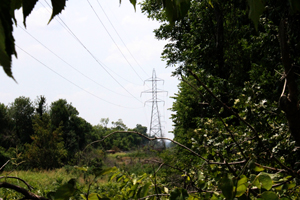
High Voltage Transmission Lines cut through the heart of the core battlefield land, as shown in this July 2011 photo. (Photo by Jeffrey S. Williams)
On the morning of the 19th [9th] I was ordered to bring up the rear with my squadron – about 6 miles from camp were attacked by the enemy. After pursuing about 2 miles we came to a creek – and received orders to form on the left of the Texas Reg. I discovered the enemy in a bend in the creek formed around a house. We routed them from this position and followed them into the swamp 200 yards distant. They flanked us and I fell back to the house. We advanced a second time and were compelled to fall back to the house – we had 80 men to their 400 or 500, fighting us with all the advantage of the creek on us and a complete natural ambuscade to protect them.
[Source: Robert A. Young, Report, 1861, Official Records, Series 1, Volume 8: 15]
Pvt. Edward Folsom
Company E, First Choctaw and Chickasaw Regiment Mounted Rifles CSA
We was in about 20 miles of the enemy old Ho-Poth-le-oh-Holo [Opothleyahola]. We lay in line of battle all night expecting them to attack us. The next morning our Creeks met them and the fight commenced. [Col.] Cooper ordered us to fall back they was too strong for us. We put the train in front and commence retreat, fighting for our train. We fell back several miles on the prairie, it was certain they would overtake us so the Gen. prepare to give battle. We formed the Choctaws on the north, and Col. [William B.] Sims Company of Texas cowboys in the center and waited and here they came. The Creeks was on the extreme left. The Pin Cherokees charged straight at us and attacked our rear guard. Just then the bugle sounded charge. I got on my horse and went for my man I had shot I got his horse and gun, everything he had in his coate pocket I found a 50c pocket knife. The northern Creeks ran to a large creek called Bird Creek and commenced fighting. We were in the prairie while they fought form the timber. Col. Sims dismounted his men and away they went I never did see such charge until they reach the brush the firing was heavy. They could not see anybody. It was not long before they all came running out Col. Sims trying to check them, but could not. I was with Capt. [Leto. M.] Renolds’ company we was to take the woods so Renolds went and another company so we took it in fine shape. There was some log house I saw the Capt. kill a man at the corner of the house. I shot a man I don’t know whether I killed but I got the scalp. Then we followed them to the creek I scalped another. It was getting dark the bugle sounded calling us back onto the prairie. There was 2 men killed on our side.
[Source: Reminiscences of E.A. Folsom, n.d., E.E. Dale Collection, Box 218, F17, OU/WHC]
Cpl. Thorton B. Heiston
Company I, First Choctaw and Chickasaw Regiment Mounted Rifles, CSA
We leave this place tomorrow for the purpose of making a “finish” of Opothleyoholo’s army. The act of secession served him as a basis upon which he has striven to consumate his long cherished hopes, seeking to become chieftain, and by misrepresentations he has induced the most ignorant of his tribe as well as a few of the Cherokee to form an alliance with the Lincoln Government. He has about 4 or 5 thousand warriors; but since suffereing two defeats his forces are now reported rapidly diminishing. The first battle was fought at Round Mountain, about 5 miles north of the Red Fork of the Arkansas. We lost only 7 men and the enemy about 50. The battle of Bird Creek the last and more important one was fought about 125 miles west of Fort Smith. The enemy numbered 4 or 5 thousand, our force was only 1400 strong. We fought 5 ½ hours; killing and wounding between 3 and 4 hundred of the enemy, and suffering the almost incredible loss of only 9 men killed and 18 wounded. Our men fought as patriots only can fight; the Choctaw regiment particularly distinguished itself and recieved the applause of the Col.
[Source: Thorton B. Heiston, Letter, May 26, 1862, Grant Foreman Collection, Box 43, Folder 97, TGM]
Sgt. George Griscom
Company D, Ninth Texas Cavalry CSA
As the rear guard was passing near Bird Creek timber they were fired upon by the enemy, our forces turned and engaged them most gallantly for 3 hours in one place then another. Our men fought on foot – about [?] pm our forces withdrew in good order. The Indians showed marked bravery, one half breed Perryman killed a foe from behind a tree took the captured gun and killed and scalped a second. The enemy were in force near 4000 strong, while we were not more than 1300. Our entire loss was 10 killed and about 20 wounded. The enemy loss ascertained to be near 200 killed and over 150 wounded.
[Source: Griscom. Fighting with Ross’ Texas Cavalry Brigade, 8-9]
Pvt. A.W. Sparks
Company I, Ninth Texas Cavalry CSA
At the break of day we marched out and started down the river on retreat, but in sequel found our retreat was to call him from his stronghold in the mountains so we could better get at him. We had marched only a few miles when we heard the rattle of guns and the chatter of the Indians, which told us of the approach of the enemy. Col. Sims formed and dismounted the regiment out on a high prairie, and gained the timber in time to meet their advance. The fighting was hot and we drove them some 2 miles up the creek, to a point where the hills come up sharp to the creek in a rough and broken way that furnished the retreating foe needed shelter. Col. Sims called the regiment to horse for the purpose of giving chase, but for the lateness of the house we did not follow. On the night after the battle, there fell about 3 inches of snow, and it was my lot to be on guard over the prisoners taken by our command, about 40.
[Source: Sparks. War Between the States, 43.]
Casualties
Privates Edward Graves and Frank Rhodes, company K; Joseph Jeffery, nok sho pa, and Pa lash tubbee, Company E and Mishoutabbee, Company C, Choctaw and Chickasaw Regiment of Mounted Rifles were killed in action. Lieutenant Ellis Folsom, Company D; Sergeant Allen McCurtain, Corporal Pa cubbee, and Private Charles Henderson, Company G; Sergeant Waletubbee, Corporal George Grahm, and Privates me she mahtubbee and Davis Wakiah, Company H; Privates John Hodges, William W. Lovejoy, Nathaniel O’Quinn, and Jesse Thornton, Company I; Private Ter shunacha, Company E; Bugler Thomas Reed, Privates Tandy Neal and William Wells, Company K, Choctaw and Chickasaw Regiment of Mounted Rifles, along with Private Ashomco tubbee, Company C, First Choctaw Mounted Rifles CSA, were wounded.
[Source: Confederate Muster Rolls, Special microfilm Collections, Roll IAD-5, passim, OHS/AD]
Additional reading:
Edwards, Whit. The Prairie was on Fire: Eyewitness Accounts of the Civil War in the Indian Territory. [Oklahoma Historical Society, Oklahoma City, OK. 2001.]
Williams, Jeffrey S. Muskets and Memories: A Modern Man’s Journey through the Civil War. [Antietam Creek Press, St. Paul, Minn. 2013.]

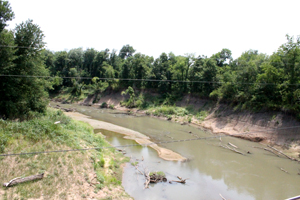

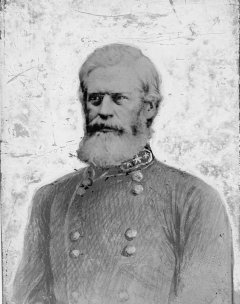
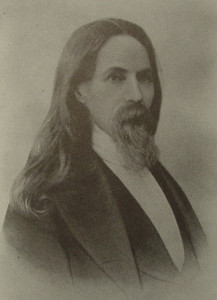
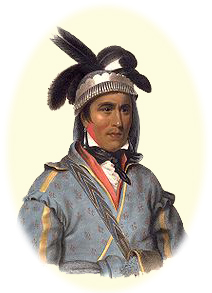
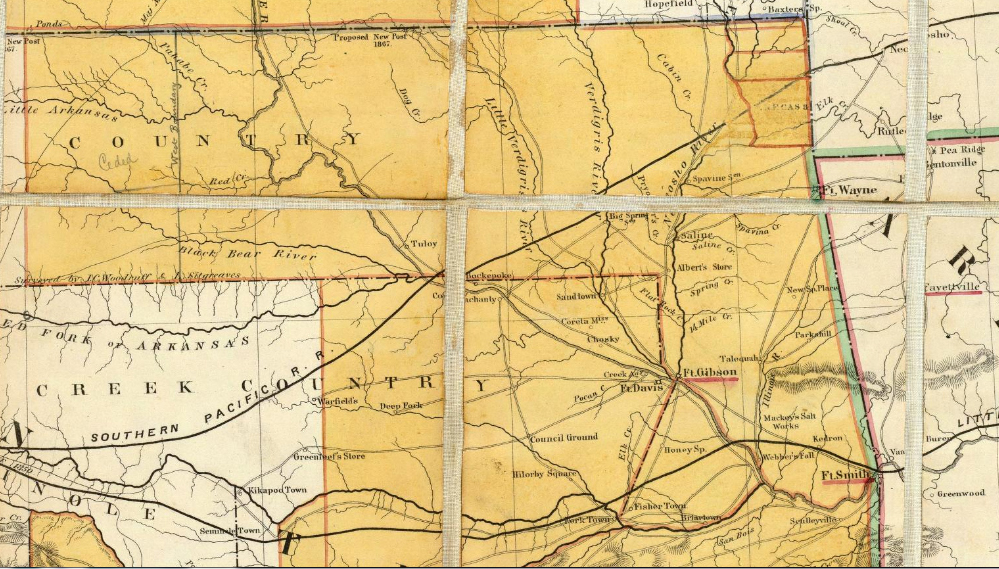

Pingback: On this date in Civil War history: November 19, 1861 - Battle of Round Mountain (150th Anniversary) | thisweekinthecivilwar
Pingback: Creek Indians in the American Civil War | thisweekinthecivilwar
Pingback: On this date in the Civil War: December 26, 1861 - The Battle of Chustenahlah (150th Anniversary) | thisweekinthecivilwar
Pingback: Douglas Hancock Cooper biography | thisweekinthecivilwar
Pingback: On this date in Civil War history: November 19, 1861 - Battle of Round Mountain (150th Anniversary) | thisweekinthecivilwar